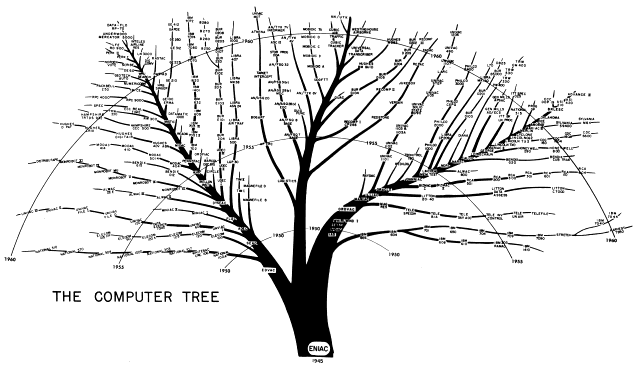 World Wide Web
World Wide WebENIACWorld Wide Web

1280x1024
version of this image (99 Kbytes).
FULL-SIZE 400dpi
version of this image (1.2 Mbytes).
The computer tree shows the evolution of electronic digital computers. The automatic computing and data processing industry is a direct outgrowth of research, sponsored by the U.S. Army Ordnance Corps, which produced the ENIAC, the world's first electronic digital computer. This industry has grown to a multi-billion dollar activity that has penetrated every profession and trade in government, business, industry, and education.
In the accompanying graphical representation of the computer tree the trunk rests on the ENIAC. The serial computers, represented by EDVAC, and the parallel computers, represented by the ORDVAC, are shown as separate limbs. This separation tends to distinguish the business computers on the left limb from the scientific computers on the right limb. The computers which were developed specifically to meet military needs are shown on the center limb. Manufacturers have entered the electronic computer field at different times, shown as various branches. Only university and government sponsored computers are shown along the limbs. The radial distance from the ENIAC is an approximate indication of the year each computer was developed, constructed, or placed in operation.
The impact of computers is tremendous. Our lives are certainly influenced by these automatons, and our very production of consumer and defense goods is indirectly controlled by them. Our national defense is entrusted to them. Our inventories and stock keeping are controlled, our records are kept, our bookkeeping is performed by them. Our routine, tedious, and painfully repetitive mental effort is ameliorated by them. We are relieved of arduous mental tasks by them much the same as we were relieved of arduous manual tasks by powered machinery. We are on the threshold of a new era and computing machines are here to stay and play an ever greater part in this era.
The computing machines described in this monograph are merely the beginners. They are the counterparts of the devices of the Howes, the Wrights, the Marconis, the Bells, and the Edisons, although they appear super- modern to us at this time. Nevertheless they are the machines which opened a new frontier in human endeavor with seemingly unlimited capabilities and applications.
(For example, research is being conducted at Frankford Arsenal on automatic checkout systems for combat vehicles, missile checkout systems, and automatic diagnostic equipment of a very sophisticated type.)